Recently Roman Parparov posted a comment here that was too important to remain buried in the comments. He asked:
Dana, are you aware that your favorite Bird got destroyed twice on the very top level very recently, in the same Nxd4, exd4, Bc4 variation:
Saric – Carlsen (!), Tromso 2014 1-0
http://www.pogonina.com/index.php?option=com_content&task=view&id=2515
Caruana (!) – Fish, Skopje 2015 1-0
http://www.chessgames.com/perl/chessgame?gid=1806290?
To answer the question directly, yes, I knew about the first game but no, I didn’t know about the second. So I appreciate the information! But of course there is an implicit question that needs to be answered: Is it still okay to play the Bird? Of course the short answer is yes. For the long answer, keep on reading.
First, it’s exciting and educational to see the two top players in the world playing my favorite variation. It was a shock to see Carlsen lose to a 2600 player and not so shocking to see Caruana beat a 2500 player. If the results of one of these games had been reversed, I imagine we would see the Bird enjoying a bit of a renaissance of popularity. However, because of the results it is all too easy for people to dismiss it. “Didn’t Fish learn anything from Saric-Carlsen?” posted one snarky commenter on chessgames.com.
The key variation that arose in both games was the following:
1. e4 e5 2. Nf3 Nc6 3. Bb5 Nd4 4. Nxd4 ed 5. Bc4 …
Of course I mentioned this earlier in my earlier post Bird by Bird: The Final Chapter, where I called this variation (and others like it) the Bashful Bishop Variation. I called it that because White retreats his bishop from b5 without waiting to be kicked by … c6. To someone looking at the Bird for the first time, White’s move looks perplexing. Didn’t White trade on d4 precisely so that his bishop would no longer be attacked? Why does he waste a tempo to move it anyway?
The answer, as I said in my earlier post, is that White understands Black’s strategic goals in the Bird Variation. The moves … c6 and … d5 are always Black’s most reliable route to equality. Therefore White makes it his top priority to prevent … d5, with Bc4 and Qf3 if necessary.
Carlsen understood this too, and in his game against Saric he would not be denied:
5. … Nf6! 6. O-O …
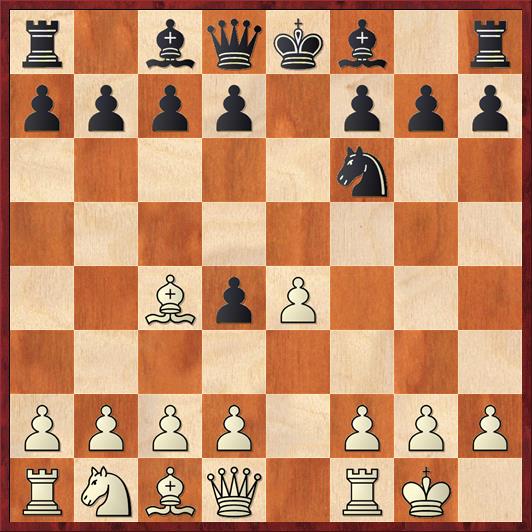 Position after 6. O-O. Black to move.
Position after 6. O-O. Black to move.
FEN: r1bqkb1r/pppp1ppp/5n2/8/2BpP3/8/PPPP1PPP/RNBQ1RK1 b kq – 0 6
6. … d5?
“I’m going to play it even if it costs me a pawn!” Carlsen says. Alas, I just don’t believe it. I’ve looked at this sacrifice and I can’t convince myself that Black gets enough compensation. Of course, I’m not the #1 player in the world, so there might be something he understands that I don’t. However, the game against Saric seems to show otherwise. After 7. ed Be7 8. Qf3 Bg4 9. Qf4 Carlsen felt it necessary to sacrifice another pawn with 9. … O-O 10. h3 Bd6 11. Qxd4, and his grateful opponent accepted the pawns and won the game very impressively.
So what should Black do here? Well, White is offering a pawn. So the most principled question is to ask what happens if we take it:
6. … Nxe4!
This is what the commentators said Carlsen should have done, and it’s what Fish played against Caruana. (By the way, I can’t help mentioning the irony of somebody named Fish playing the Bird Variation. I am very tempted to call this the Birdfish Subvariation.) The position is very much like a Max Lange for Black, only better. If White plays 7. Re1, which has occurred in my only two tournament games with this line, Black equalizes easily with 7. … d5. If 8. Bxd5 Qxd5 as in Higgins-Mackenzie 2005, White can’t play his normal Max Lange move 9. Nc3. (In the Max Lange, White would not have a pawn on d2 and Nc3 would be the correct move.) Instead Higgins played 9. d3 and I eventually won. If instead White plays 8. d3 as in Bick-Mackenzie 2013, 8. … dc 9. Rxe4+ Be6 10. dc c5 seemed fine for Black and I eventually drew.
Alas, there is one slight fly in the ointment. White has a tactical shot:
7. Bxf7+! Kxf7 8. Qh5+ g6 9. Qd5+ Kg7 10. Qxe4.
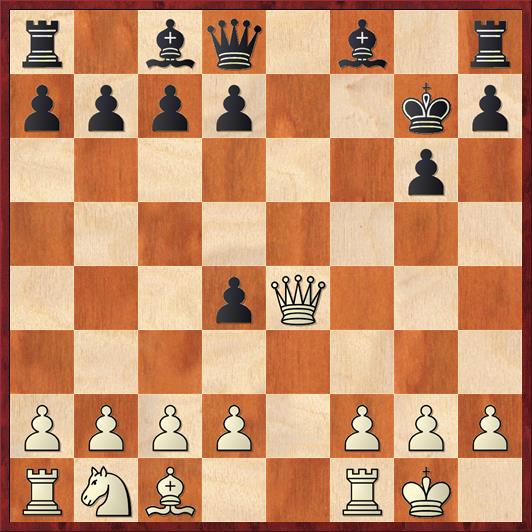 Position after 10. Qxe4. Black to move.
Position after 10. Qxe4. Black to move.
FEN: r1bq1b1r/pppp2kp/6p1/8/3pQ3/8/PPPP1PPP/RNB2RK1 b – – 0 10
This is really the starting point of the Birdfish Variation. Black has two ways to defend the d-pawn: 10. … c5 and 10. … Qf6. (10. … Bc5?? would of course lose a piece to 11. Qe5+.) Fish played 10. … Qf6, and it’s what I recommend. The problem with 10. … c5 is that it’s too defensive and Black is playing for a draw at the absolute best. However, I found a game in this variation that is very much worth looking at, because it shows why the endgame is not an automatic win for White.
The game Krejci-Vrana, Czech Republic 2009, went 10. … c5 11. d3 Qe7 12. Qf3 Qf7 13. Bf4 Be7 14. Be5+ Bf6 15. Bxf6+ Qxf6 16. Qxf6+ Kxf6. Basically White is saying, “I don’t even have to try to attack you, because the endgame is already won. I have an extra pawn on the kingside and you can never create a passed pawn on the queenside.” But Vrana showed that the long-range power of the bishop can just compensate for being effectively a pawn down. They reached the following key endgame position:
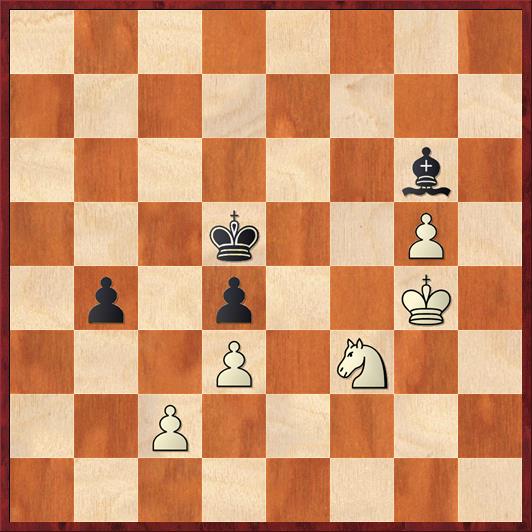 Position after 58. … Kd5. White to move.
Position after 58. … Kd5. White to move.
FEN: 8/8/6b1/3k2P1/1p1p2K1/3P1N2/2P5/8 w – – 0 59
In spite of being really (not just “effectively”) a pawn up, White was not able to make progress. If the knight gets too frisky, say with 59. Nh4 or 59. Kf4 planning Ne5, Black strikes first with 59. … b3! and this is good enough to draw. White tried first 59. Ne1 and later (in the same position) 59. Nd2, but neither of these moves makes any threats, so Black can just sit on the position. The players shortly agreed to a draw.
My point here is not that Black should play this way — it would be nerve-racking to have to defend a position like this every time — but to make two points:
- White cannot just blindly trade pieces and expect to win. He has to try to improve his position in the middlegame.
- Black must keep his light-squared bishop! That is his biggest advantage in the position. In any minor-piece endgame, whether it’s opposite-color bishops or bishop versus knight, that’s the piece that makes it tenable.
Now let’s get to the recommended variation from the second diagram, 10. … Qf6. That’s what Fish played against Caruana. In a later comment, Roman said that he put this position on Stockfish overnight and it vacillated between an assessment of +0.4 to +0.6 for White.
First of all, I’m not intimidated or scared off by a computer assessment of -0.5 pawns. I’ve seen that in other Bird variations, too. What really matters to me are two things:
- Do I understand Black’s strategic ideas?
- Does Black have the potential to make mischief?
If I can give a solid “Yes” to both questions, then I can play this position. My opponents are not computers, and they will eventually flounder. (Bad pun, I know. Birdfish Variation, floundering, get it?)
After 10. … Qf6, the obvious and surely best move for White is 11. d3. Fish played 11. … c6, which I agree with. In the Bird Black should almost always strive for … c6 and … d5 instead of getting locked into the passive d6-c5-d4 structure.
Then Caruana played 12. Bf4! and we start seeing where Black’s problems are. His planned 12. … d5? simply loses, or close to it, after 13. Qe5! Be7 14. Qc7. So Fish was forced to make a positional concession with 12. … d6. Score a small victory for White and for Caruana. But the game is not over. Caruana now played 13. Ne2 Bf5 14. Qf3 (it’s hard to tell which is better, this move or Qe2) and now is when I think Fish went wrong.
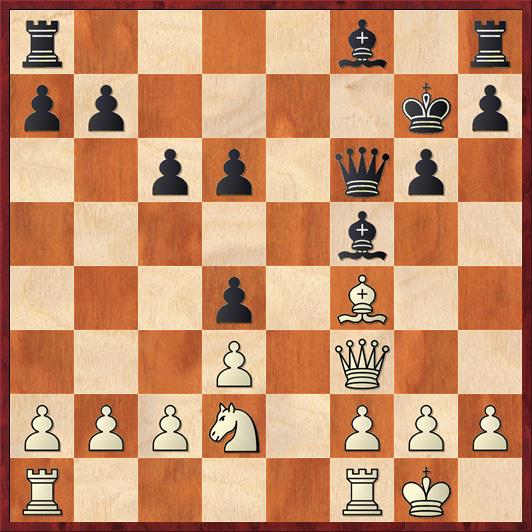 Position after 14. Qf3. Black to move.
Position after 14. Qf3. Black to move.
FEN: r4b1r/pp4kp/2pp1qp1/5b2/3p1B2/3P1Q2/PPPN1PPP/R4RK1 b – – 0 14
Here Fish played 14. … Be7? and the initiative passed over to White after 15. Rae1 Rhe8 16. Ne4! Bxe4 17. Rxe4. Remember how I said that the one minor piece Black wants to hold onto is the light-squared bishop? The fact that Black has had to give it up so easily is a sign that something has gone wrong.
When I looked at this position, practically my first thought was, “Well, what about 14. g5!?” At first I thought it was just a crazy idea, weakening Black’s kingside, but the more I looked at it and the more I realized the hopelessness of Black’s position if he doesn’t play this move, the more I became convinced that it is a must.
Here is why 14. … g5! is such a good move.
- The paramount thing in this position is to fight for the initiative. Black takes advantage of the fact that White’s bishop has only one flight square and even after it goes there it’s not out of trouble.
- The apparent weaknesses on the kingside are not weaknesses if White can’t attack them. The pawn on g5 will shortly be joined by a pawn on h5. Both pawns are mobile and not easily attacked.
- White’s pieces, the queen and bishop, are stuck in front of his pawns where they are (a) easy targets and (b) get in the way of the pawn moves White would like to make to challenge Black’s pawn storm (especially the queen is in the way of f2-f4).
- Even if White succeeds in playing f4 and Black gets his pawns fixed on h5 and g4, the endgame offers Black good drawing chances because that f-pawn is easily blockaded.
- And finally, there’s a trap…
I’ve spent quite a while analyzing this position and haven’t been able to reach a concrete assessment. I don’t see a clear way for Black to prove equality and I also don’t see a clear way for White to achieve an advantage. It’s just going to be hard-nosed chess. But what I like is that Black is the one with active pieces and a clear plan of expansion on the kingside.
The trap is that White cannot reply 15. Qg3? because of the wicked reply 15. … Kh6, and White’s bishop has no exit! (Modl-Botsari, Women’s Interzonal 1990). 16. Qh4+ Kg6 17. Qg3 leads to a draw by repetition at best. So White is forced to give ground with 15. Bg3, which is already an encouraging sign. I see no reason for Black not to play 15. … h5, once again threatening to trap the bishop and not giving White time to play Ne4. White’s most likely response is 16. h3, and now I think 16. … Re8 is best for Black. (It’s not clear yet whether I want to advance the g-pawn or the h-pawn, so for the time being I will not commit myself.)
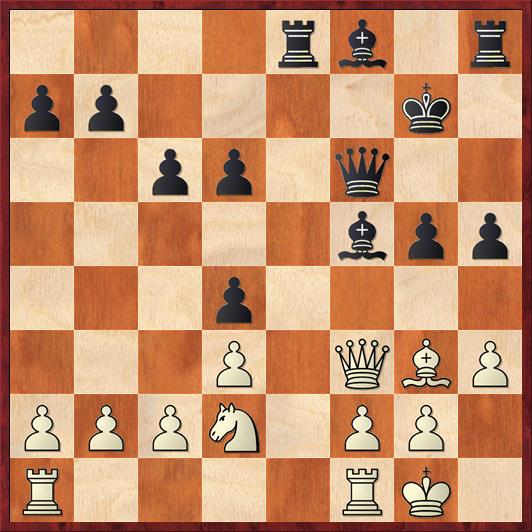 Position after 16. … Re8. White to move.
Position after 16. … Re8. White to move.
FEN: 4rb1r/pp4k1/2pp1q2/5bpp/3p4/3P1QBP/PPPN1PP1/R4RK1 w – – 0 17
If 17. Rae1 my plan is to play 17. … Re6. If 17. Ne5 I have a tough choice to make. I might play 17. … Bxe5, with some remorse because it means giving up my good bishop, but it dramatically changes the strategy after 18. de because Black will now have the ability to create as many passed pawns on the Queenside as White can on the kingside. Alternatively, I might play 17. … Qg6 and offer a pawn sacrifice with 18. Nxd6 Bxd6 19. Bxd6.
In the end I don’t have a clear evaluation — I’m not sure that Black can prove he has full equality and I’m not sure that White can prove he has an advantage. But that’s chess! The key thing for me, as Black, is that I’ve succeeded in making mischief, and White is not going to be able to win by squeezing me to death. It’s a good dynamic position and certainly playable for Black, with lots of chances for White to go wrong.



{ 4 comments… read them below or add one }
Dana, I understand that this continuation should be somewhat playable; my point is that Caruana had that line, and not 5. 0-0 prepared for the Bird, and that is somewhat discouraging. Sometimes you see a top player executing a convincing kill of a variation and that puts you off.
I remember I stopped playing Queen Indian Defense main variation after seeing several demolitions in Polugaevsky’s gambit and after finally being run over in 1987 myself. Luckily, soon I saw a comprehensive article on the Blumenfeld gambit. 🙂
We, the 2100-2400 players who are 30+ years old are bound to stick with the offbeat. For me, the main playability of an offbeat variation is pending on whether the other side has to play unusual, specific, concrete moves to disarm it. I play Bronstein-Larsen variation of the CK, it’s one of these. Alekhine Defense is not, for example. Actually, except for a couple of openings (classical CK and Alekhine as white, 1.c4 e5 as Black) I think I turn into the offbeat by move 6-7 anywhere…
Yes, I’ve had this experience a couple times. Before I took up the Bird Variation I used to play the Steinitz Deferred (1. e4 e5 2. Nf3 Nc6 3. Bb5 a6 4. Ba4 d6) with the intention of going into the Siesta Variation (5. c3 f5) if my opponent allowed it. But I seldom got a chance to play the Siesta because people usually played 5. O-O or 5. d4. Then there was a game Anand-Yusupov where Anand basically refuted the main line of the Siesta. (6. ef Bxf5 7. O-O Bd3 8. Re1 Nf6 9. Bc2 Bxc2 10. Qxc2 Be7 11. d4 O-O 12. d5!)
After that, for me, the whole point of playing the Steinitz Deferred collapsed. I could of course play 5. … Bd7 instead of 5. … f5, but it looked passive and uninteresting — not the way I wanted to play chess. That’s when I switched over to the Bird Variation.
By contrast, the 5. Bc4 line against the Bird seems interesting to me rather than scary. It gives me more incentive to play the line, rather than less.
Heh, I’d say the 5.0-0 puts the steam out of the Siesta. 5. … Bg4 is insufficient, unlike in the similar Exchange variation lines, and 5. … Bd7 brings you back into the Keczkemet-like positions (or Duras variation).
I checked out the current status of the Siesta. At least in the 2000s Yandemirov and Winants played it on the 2500-level, however the games always continued 11. … e4 12.Ng5 d5 13.f3 h6, with the majority of the latest games drawn.
And I think that the Deferred Steinitz is one of the best openings for a 1800-2000 level (albeit possibly insufficient for us).
On the 16. move 16.h4 seems interesting, intending to swap the queens and head for that ending with an extra pawn on the K-side, but with dark-colored bishop for black, which is far less dangerous than the other one.